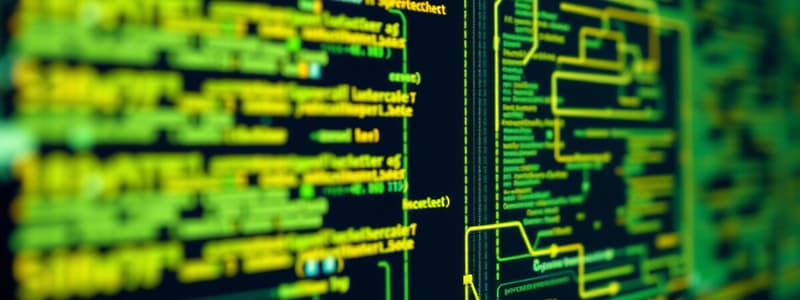Podcast
Questions and Answers
Wat is de primaire verantwoordelijkheid van een data-administrator (DA)?
Wat is de primaire verantwoordelijkheid van een data-administrator (DA)?
- Ontwikkeling van toepassingsprogramma's
- Verantwoordelijk voor de data en ontwerp van databases (correct)
- Beheren van databeveiliging en gebruikersrechten
- Implementatie en onderhoud van databases
Welke functie heeft een database-administrator (DBA) binnen een organisatie?
Welke functie heeft een database-administrator (DBA) binnen een organisatie?
- Toezicht houden op eindgebruikers
- Het uitvoeren van gegevensanalyses
- Verantwoordelijk voor het testen van software
- Technisch verantwoordelijk voor database-implementatie en -onderhoud (correct)
Wat houdt datamanipulatie in binnen een database management systeem?
Wat houdt datamanipulatie in binnen een database management systeem?
- Operaties uitvoeren zoals toevoegen, aanpassen en verwijderen van data (correct)
- Aanmaken van nieuwe databasegebruikers
- Definiëren van de databasestructuur
- Observeren van netwerkprestaties
Waarom zijn integriteitsrestricties belangrijk in een database?
Waarom zijn integriteitsrestricties belangrijk in een database?
Wat is een kenmerk van een data warehouse?
Wat is een kenmerk van een data warehouse?
Wat is een mogelijke functie van rapportgeneratoren in een databanksysteem?
Wat is een mogelijke functie van rapportgeneratoren in een databanksysteem?
Wat zorgt ervoor dat meerdere gebruikers tegelijk in een databanksysteem toegang kunnen hebben zonder conflicten?
Wat zorgt ervoor dat meerdere gebruikers tegelijk in een databanksysteem toegang kunnen hebben zonder conflicten?
Wat is de rol van software voor data-analyse in een databanksysteem?
Wat is de rol van software voor data-analyse in een databanksysteem?
Wat is de verantwoordelijkheid van de reguliere eindgebruiker in een databasesysteem?
Wat is de verantwoordelijkheid van de reguliere eindgebruiker in een databasesysteem?
Welke taak behoort niet tot de hoofdfunctionaliteiten van een DBMS?
Welke taak behoort niet tot de hoofdfunctionaliteiten van een DBMS?
Wat is het belangrijkste verschil tussen data en informatie?
Wat is het belangrijkste verschil tussen data en informatie?
Waarom is het belangrijk dat een databank up-to-date wordt gehouden?
Waarom is het belangrijk dat een databank up-to-date wordt gehouden?
Wat verwijst de term 'persistente data' naar?
Wat verwijst de term 'persistente data' naar?
Welk aspect beïnvloedt de keuze van data die in een databank wordt opgeslagen?
Welk aspect beïnvloedt de keuze van data die in een databank wordt opgeslagen?
Wat is een databasesysteem?
Wat is een databasesysteem?
Wat was de belangrijkste innovatie van de ‘Analytical engine’ van Charles Babbage?
Wat was de belangrijkste innovatie van de ‘Analytical engine’ van Charles Babbage?
Welke laag is toegevoegd in de drielagen-systeemarchitectuur ten opzichte van de tweelagen-architectuur?
Welke laag is toegevoegd in de drielagen-systeemarchitectuur ten opzichte van de tweelagen-architectuur?
Wat doet een databasemanagementsysteem (DBMS) precies?
Wat doet een databasemanagementsysteem (DBMS) precies?
Wat geeft een recordtype aan binnen een database?
Wat geeft een recordtype aan binnen een database?
Wat is het primaire doel van secundaire bestandorganisatie in een databasesysteem?
Wat is het primaire doel van secundaire bestandorganisatie in een databasesysteem?
Welke technologie wordt gebruikt in flashgeheugen?
Welke technologie wordt gebruikt in flashgeheugen?
Wat beschrijft het fenomeen van volatiel geheugen?
Wat beschrijft het fenomeen van volatiel geheugen?
Welke rol speelt de CPU binnen een databasesysteem?
Welke rol speelt de CPU binnen een databasesysteem?
Hoe zijn velden en records gestructureerd binnen een database?
Hoe zijn velden en records gestructureerd binnen een database?
Welke mogelijkheid biedt het gebruik van magneetbanden in databases?
Welke mogelijkheid biedt het gebruik van magneetbanden in databases?
Welke van de volgende datatypes kan niet worden gebruikt in een recordtype?
Welke van de volgende datatypes kan niet worden gebruikt in een recordtype?
Wat is een vreemde sleutel in een database?
Wat is een vreemde sleutel in een database?
Wat is de functie van een toepassingsprogramma in relatie tot een DBMS?
Wat is de functie van een toepassingsprogramma in relatie tot een DBMS?
Flashcards
Data
Data
Individual pieces of information without context, like "Rotterdam" or "1882".
Information
Information
Data combined with meaning, creating understanding. For example, "The painting 'Fisherman's Cottage' by Monet, painted in 1882, is housed in the Boijmans van Beuningen Museum in Rotterdam."
Database
Database
A structured and organized collection of persistent data, managed by a computer system. It stores information in a logical format.
Persistent data
Persistent data
Signup and view all the flashcards
Database Management System (DBMS)
Database Management System (DBMS)
Signup and view all the flashcards
Codex of Hammurabi
Codex of Hammurabi
Signup and view all the flashcards
Physice Akroasis
Physice Akroasis
Signup and view all the flashcards
Analytical Engine
Analytical Engine
Signup and view all the flashcards
Two-Layer Database Architecture
Two-Layer Database Architecture
Signup and view all the flashcards
Three-Layer Database Architecture
Three-Layer Database Architecture
Signup and view all the flashcards
Components of a Database System
Components of a Database System
Signup and view all the flashcards
Central Processing Unit (CPU)
Central Processing Unit (CPU)
Signup and view all the flashcards
Memory Hierarchy
Memory Hierarchy
Signup and view all the flashcards
Primary Memory
Primary Memory
Signup and view all the flashcards
Secondary Memory
Secondary Memory
Signup and view all the flashcards
Buffer Size
Buffer Size
Signup and view all the flashcards
Record
Record
Signup and view all the flashcards
Record Type
Record Type
Signup and view all the flashcards
Data Type
Data Type
Signup and view all the flashcards
Record Relationships
Record Relationships
Signup and view all the flashcards
Database Management System (DBMS)
Database Management System (DBMS)
Signup and view all the flashcards
Application Programs
Application Programs
Signup and view all the flashcards
Communication Software
Communication Software
Signup and view all the flashcards
Data Warehouse
Data Warehouse
Signup and view all the flashcards
Data Analysis Software
Data Analysis Software
Signup and view all the flashcards
Report Generator
Report Generator
Signup and view all the flashcards
User Profiles
User Profiles
Signup and view all the flashcards
Data Administrator (DA)
Data Administrator (DA)
Signup and view all the flashcards
Database Administrator (DBA)
Database Administrator (DBA)
Signup and view all the flashcards
Application Developers and End-Users
Application Developers and End-Users
Signup and view all the flashcards
DBMS Functions
DBMS Functions
Signup and view all the flashcards
Database Definition
Database Definition
Signup and view all the flashcards
Database Manipulation
Database Manipulation
Signup and view all the flashcards
Database Construction
Database Construction
Signup and view all the flashcards
Concurrent Access
Concurrent Access
Signup and view all the flashcards
Security
Security
Signup and view all the flashcards
Secondary File Organization
Secondary File Organization
Signup and view all the flashcards
Administration and Monitoring
Administration and Monitoring
Signup and view all the flashcards
Study Notes
Basisconcepten van databases
- Data zijn losse gegevens zonder context, zoals "Rotterdam" of "1882".
- Informatie ontstaat wanneer data samen met betekenis gegeven worden, bijvoorbeeld "In het museum Boijmans van Beuningen te Rotterdam bevindt zich het schilderij ‘Vissershuis’ dat in 1882 door Monet werd geschilderd."
- Een database is een gestructureerde verzameling persistente data, beheerd door een computersysteem dat deze informatie opslaat in een logische structuur.
- Persistente data blijft opgeslagen in permanent geheugen, ook na uitschakeling van de computer.
- Een databasesysteem beheert databases en de data-inhoud is afhankelijk van de behoeften van een bedrijf.
Geschiedenis van gegevensbeheer
- Codex van Hammoerabi (2000 voor Christus): eerste registratie van data.
- 'Fysice akroasis' van Aristoteles (384-322 voor Christus): ordening en structureren van data.
- 'Analytical engine' van Charles Babbage (1830): geautomatiseerde registratie van data en programmeren van machineacties.
- Eerste databasesystemen (1960-1970): tweelagen systeemarchitectuur met interne en logische lagen; opslag met magneetband en magneetschijf.
- Drielagen systeemarchitectuur (1970-1980): introduceert een externe laag voor verschillende datavisualisatie; relationeel databasemodel gepresenteerd door Codd in 1970.
Componenten van een databasesysteem
- Drie hoofdcomponenten: hardware, data en software.
- Gebruikers spelen ook een cruciale rol in het functionele aspect van databasesystemen.
Hardware
- Central Processing Unit (CPU): verantwoordelijk voor uitvoering van software-instructies, met variërende snelheid (bijv. 3 GHz).
- Geheugen hiërarchisch georganiseerd:
- Primair geheugen: snel toegankelijk (RAM, zowel statisch als dynamisch).
- Secundair geheugen: voor persistente data (harde schijven, CD-ROM, DVD).
- Buffergrootte in primair geheugen is cruciaal voor efficiëntie.
Data en records
- Een database bestaat uit records, elk samengesteld uit één of meer velden met data.
- Recordtype definieert de velden met naam en datatype (bijv. CHAR, INTEGER, REAL).
- Toegestane waarden worden bepaald door het datatype; koppelingen tussen records creëren context.
Software
- Databasemanagementsysteem (DBMS): beheert databases, verantwoordelijk voor opzoeken, toevoegen, wijzigen en verwijderen van data.
- Toepassingsprogramma’s verbinden gebruikers met DBMS en vertalen acties naar databaseoperaties.
- Communicatiesoftware maakt data-overdracht mogelijk over netwerken in gedistribueerde systemen.
Datawarehousing
- Een database voor data-analyse, houdt vaak historische gegevens bij en integreert deze op regelmatige basis.
- Software voor data-analyse helpt bij het ontdekken van zinvolle verbanden in data.
- Rapportgeneratoren creëren automatische rapporten over database-inhoud.
Gebruikers en hun profielen
- Gebruikersprofielen zijn essentieel voor interactie met databasesystemen.
- Belangrijke profielen omvatten:
- Data-administrator (DA): verantwoordelijk voor databeheer en toegang.
- Database-administrator (DBA): technisch verantwoordelijk voor implementatie en onderhoud.
- Toepassingsontwikkelaar en eindgebruikers met verschillende niveaus van interactie en complexiteit.
Functionele aspecten van DBMS
- Hoofdfuncties: definitie, manipulatie en constructie van databases.
- Definitie omvat vastleggen van databasestructuur en semantische regels ter waarborging van integriteit.
- Manipulatie betreft het toevoegen, aanpassen, verwijderen en opzoeken van data via datamanipulatietaal.
- Constructie omvat het opzetten van een primaire bestandorganisatie en omzetten van databasestructuur naar recordstructuur.
Andere functies van het DBMS
- Simultane toegang voor gebruikers, cruciaal voor het voorkomen van conflicten, zoals dubbele boekingen.
- Beveiliging tegen ongeoorloofd gebruik en dataverlies.
- Efficiënte secundaire bestandsorganisatie (bijv. indexering) voor optimaal systeemgedrag.
- Administratie en controle van prestaties, gebruikersprofielen en back-ups.
Studying That Suits You
Use AI to generate personalized quizzes and flashcards to suit your learning preferences.




